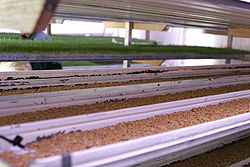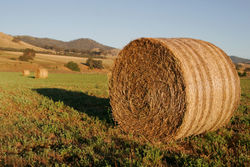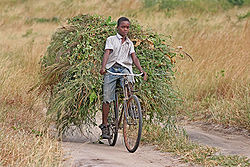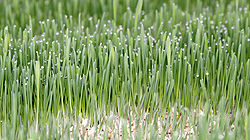
Fodder
Encyclopedia

Agriculture
Agriculture is the cultivation of animals, plants, fungi and other life forms for food, fiber, and other products used to sustain life. Agriculture was the key implement in the rise of sedentary human civilization, whereby farming of domesticated species created food surpluses that nurtured the...
food
Food
Food is any substance consumed to provide nutritional support for the body. It is usually of plant or animal origin, and contains essential nutrients, such as carbohydrates, fats, proteins, vitamins, or minerals...
stuff used specifically to feed domesticated livestock
Livestock
Livestock refers to one or more domesticated animals raised in an agricultural setting to produce commodities such as food, fiber and labor. The term "livestock" as used in this article does not include poultry or farmed fish; however the inclusion of these, especially poultry, within the meaning...
such as cattle
Cattle
Cattle are the most common type of large domesticated ungulates. They are a prominent modern member of the subfamily Bovinae, are the most widespread species of the genus Bos, and are most commonly classified collectively as Bos primigenius...
, goats, sheep, horses, chicken
Chicken
The chicken is a domesticated fowl, a subspecies of the Red Junglefowl. As one of the most common and widespread domestic animals, and with a population of more than 24 billion in 2003, there are more chickens in the world than any other species of bird...
s and pig
Pig
A pig is any of the animals in the genus Sus, within the Suidae family of even-toed ungulates. Pigs include the domestic pig, its ancestor the wild boar, and several other wild relatives...
s. Most animal feed is from plants but some is of animal origin. "Fodder" refers particularly to food given to the animals (including plants cut and carried to them), rather than that which they forage for themselves (see forage
Forage
Forage is plant material eaten by grazing livestock.Historically the term forage has meant only plants eaten by the animals directly as pasture, crop residue, or immature cereal crops, but it is also used more loosely to include similar plants cut for fodder and carried to the animals, especially...
). It includes hay
Hay
Hay is grass, legumes or other herbaceous plants that have been cut, dried, and stored for use as animal fodder, particularly for grazing livestock such as cattle, horses, goats, and sheep. Hay is also fed to pets such as rabbits and guinea pigs...
, straw
Straw
Straw is an agricultural by-product, the dry stalks of cereal plants, after the grain and chaff have been removed. Straw makes up about half of the yield of cereal crops such as barley, oats, rice, rye and wheat. It has many uses, including fuel, livestock bedding and fodder, thatching and...
, silage
Silage
Silage is fermented, high-moisture fodder that can be fed to ruminants or used as a biofuel feedstock for anaerobic digesters. It is fermented and stored in a process called ensiling or silaging, and is usually made from grass crops, including corn , sorghum or other cereals, using the entire...
, compressed and pelleted feeds
Compound feed
Compound feeds are feedstuffs that are blended from various raw materials and additives. These blends are formulated according to the specific requirements of the target animal...
, oils and mixed rations, and also sprouted grains and legumes.
The worldwide animal feed industry consumed tons of feed (compound feed
Compound feed
Compound feeds are feedstuffs that are blended from various raw materials and additives. These blends are formulated according to the specific requirements of the target animal...
equivalent) in 2006, with an annual growth rate of about 2%. The use of agricultural land to grow feed rather than human food can be controversial; some types of feed, such as corn (maize
Maize
Maize known in many English-speaking countries as corn or mielie/mealie, is a grain domesticated by indigenous peoples in Mesoamerica in prehistoric times. The leafy stalk produces ears which contain seeds called kernels. Though technically a grain, maize kernels are used in cooking as a vegetable...
), can also serve as human food; those that cannot, such as grassland
Grassland
Grasslands are areas where the vegetation is dominated by grasses and other herbaceous plants . However, sedge and rush families can also be found. Grasslands occur naturally on all continents except Antarctica...
grass, may be grown on land that can be used for crops consumed by humans. Some agricultural by-product
By-product
A by-product is a secondary product derived from a manufacturing process or chemical reaction. It is not the primary product or service being produced.A by-product can be useful and marketable or it can be considered waste....
s which are fed to animals may be considered unsavory by human consumers.
Common plants specifically grown for fodder


- AlfalfaAlfalfaAlfalfa is a flowering plant in the pea family Fabaceae cultivated as an important forage crop in the US, Canada, Argentina, France, Australia, the Middle East, South Africa, and many other countries. It is known as lucerne in the UK, France, Australia, South Africa and New Zealand, and known as...
(lucerne) - BarleyBarleyBarley is a major cereal grain, a member of the grass family. It serves as a major animal fodder, as a base malt for beer and certain distilled beverages, and as a component of various health foods...
- Birdsfoot trefoil
- BrassicaBrassicaBrassica is a genus of plants in the mustard family . The members of the genus may be collectively known either as cabbages, or as mustards...
spp.- KaleKaleKale is very high in beta carotene, vitamin K, vitamin C, lutein, zeaxanthin, and reasonably rich in calcium. Kale, as with broccoli and other brassicas, contains sulforaphane , a chemical with potent anti-cancer properties. Boiling decreases the level of sulforaphane; however, steaming,...
- RapeseedRapeseedRapeseed , also known as rape, oilseed rape, rapa, rappi, rapaseed is a bright yellow flowering member of the family Brassicaceae...
(canola) - RutabagaRutabagaThe rutabaga, swede , turnip or yellow turnip is a root vegetable that originated as a cross between the cabbage and the turnip; see Triangle of U...
(swede) - TurnipTurnipThe turnip or white turnip is a root vegetable commonly grown in temperate climates worldwide for its white, bulbous taproot. Small, tender varieties are grown for human consumption, while larger varieties are grown as feed for livestock...
- Kale
- CloverCloverClover , or trefoil, is a genus of about 300 species of plants in the leguminous pea family Fabaceae. The genus has a cosmopolitan distribution; the highest diversity is found in the temperate Northern Hemisphere, but many species also occur in South America and Africa, including at high altitudes...
- Alsike cloverTrifolium hybridumTrifolium hybridum, alsike clover, is a plant species of the genus Trifolium in the pea family Fabaceae. The stalked, pale pink or whitish flower head grows from the leaf axils, and the trifoliate leaves are unmarked. The plant is tall, and is found in fields and on roadsides – it is also...
- Red cloverRed cloverTrifolium pratense is a species of clover, native to Europe, Western Asia and northwest Africa, but planted and naturalised in many other regions....
- Subterranean cloverSubterranean cloverTrifolium subterraneum, the Subterranean clover often shortened to sub clover, is a species of clover native to northwestern Europe, from Ireland east to Belgium...
- White cloverWhite cloverTrifolium repens, the white clover , is a species of clover native to Europe, North Africa, and West Asia...
- Alsike clover
- GrassGrassGrasses, or more technically graminoids, are monocotyledonous, usually herbaceous plants with narrow leaves growing from the base. They include the "true grasses", of the Poaceae family, as well as the sedges and the rushes . The true grasses include cereals, bamboo and the grasses of lawns ...
- Bermuda grass
- BromeBromusBromus is a large genus of the grass family . Estimates in the scientific literature of the number of species have ranged from 100 to 400, but plant taxonomists currently recognize around 160–170 species...
- False oat grassArrhenatherumArrhenatherum, commonly called Oat-grass or Button-grass, is a genus with seven species and subspecies from the grass family Poaceae. It grows in Europe and the Mediterranean. Wild forms resemble Wild Oat or Fescue...
- FescueFescueFestuce is a genus of about 300 species of perennial tufted grasses, belonging to the grass family Poaceae . The genus has a cosmopolitan distribution, although the majority of the species are found in cool temperate areas...
- Heath grassDanthoniaDanthonia is a genus of grass species. Grasses of this genus are sometimes referred to as oatgrass, but that common name is not restricted to this genus.Species include:*Danthonia alpina Vest*Danthonia cachemyriana Jaub. & Spach...
- MeadowMeadowA meadow is a field vegetated primarily by grass and other non-woody plants . The term is from Old English mædwe. In agriculture a meadow is grassland which is not grazed by domestic livestock but rather allowed to grow unchecked in order to make hay...
grasses (from naturally mixed grassland swards) - Orchard grass
- RyegrassRyegrassRyegrass is a genus of nine species of tufted grasses in the Pooideae subfamily of the Poaceae family. Also called tares , these plants are native to Europe, Asia and northern Africa, but are...
- Timothy-grassTimothy-grassTimothy-grass , is an abundant perennial grass native to most of Europe except for the Mediterranean region. It grows to 50–150 cm tall, with leaves up to 45 cm long and 1 cm broad. The flowerhead is 7–15 cm long and 8–10 mm broad, with densely packed spikelets...
- Corn (maizeMaizeMaize known in many English-speaking countries as corn or mielie/mealie, is a grain domesticated by indigenous peoples in Mesoamerica in prehistoric times. The leafy stalk produces ears which contain seeds called kernels. Though technically a grain, maize kernels are used in cooking as a vegetable...
) - MilletMilletThe millets are a group of small-seeded species of cereal crops or grains, widely grown around the world for food and fodder. They do not form a taxonomic group, but rather a functional or agronomic one. Their essential similarities are that they are small-seeded grasses grown in difficult...
- OatOatThe common oat is a species of cereal grain grown for its seed, which is known by the same name . While oats are suitable for human consumption as oatmeal and rolled oats, one of the most common uses is as livestock feed...
s - SorghumSorghumSorghum is a genus of numerous species of grasses, one of which is raised for grain and many of which are used as fodder plants either cultivated or as part of pasture. The plants are cultivated in warmer climates worldwide. Species are native to tropical and subtropical regions of all continents...
- SoybeanSoybeanThe soybean or soya bean is a species of legume native to East Asia, widely grown for its edible bean which has numerous uses...
s - TreeTreeA tree is a perennial woody plant. It is most often defined as a woody plant that has many secondary branches supported clear of the ground on a single main stem or trunk with clear apical dominance. A minimum height specification at maturity is cited by some authors, varying from 3 m to...
s (pollardPollardingPollarding is a pruning system in which the upper branches of a tree are removed, promoting a dense head of foliage and branches. It has been common in Great Britain and Europe since medieval times and is practiced today in urban areas worldwide, primarily to maintain trees at a predetermined...
tree shoots for "tree-hay") - WheatWheatWheat is a cereal grain, originally from the Levant region of the Near East, but now cultivated worldwide. In 2007 world production of wheat was 607 million tons, making it the third most-produced cereal after maize and rice...
Types of fodder
- Conserved forage plants: hayHayHay is grass, legumes or other herbaceous plants that have been cut, dried, and stored for use as animal fodder, particularly for grazing livestock such as cattle, horses, goats, and sheep. Hay is also fed to pets such as rabbits and guinea pigs...
and silageSilageSilage is fermented, high-moisture fodder that can be fed to ruminants or used as a biofuel feedstock for anaerobic digesters. It is fermented and stored in a process called ensiling or silaging, and is usually made from grass crops, including corn , sorghum or other cereals, using the entire... - Compound feedCompound feedCompound feeds are feedstuffs that are blended from various raw materials and additives. These blends are formulated according to the specific requirements of the target animal...
and premixes, often called pellets, nuts or (cattle) cake. - Crop residues: stoverStoverStover is the leaves and stalks of corn , sorghum or soybean plants that are left in a field after harvest. It can be directly grazed by cattle or dried for use as fodder. It is similar to straw, the residue left after any cereal grain or grass has been harvested at maturity for its seed...
, copraCopraCopra is the dried meat, or kernel, of the coconut. Coconut oil extracted from it has made copra an important agricultural commodity for many coconut-producing countries. It also yields coconut cake which is mainly used as feed for livestock.-Production:...
, strawStrawStraw is an agricultural by-product, the dry stalks of cereal plants, after the grain and chaff have been removed. Straw makes up about half of the yield of cereal crops such as barley, oats, rice, rye and wheat. It has many uses, including fuel, livestock bedding and fodder, thatching and...
, chaffChaffChaff is the dry, scaly protective casings of the seeds of cereal grain, or similar fine, dry, scaly plant material such as scaly parts of flowers, or finely chopped straw...
, sugar beetSugar beetSugar beet, a cultivated plant of Beta vulgaris, is a plant whose tuber contains a high concentration of sucrose. It is grown commercially for sugar production. Sugar beets and other B...
waste - Fish mealFish mealFish meal, or fishmeal, is a commercial product made from both whole fish and the bones and offal from processed fish. It is a brown powder or cake obtained by rendering pressing the cooked whole fish or fish trimmings to remove most of the fish oil and water, and then ground...
- Freshly cut grassGrassGrasses, or more technically graminoids, are monocotyledonous, usually herbaceous plants with narrow leaves growing from the base. They include the "true grasses", of the Poaceae family, as well as the sedges and the rushes . The true grasses include cereals, bamboo and the grasses of lawns ...
and other forage plants - Meat and bone mealMeat and bone mealMeat and bone meal is a product of the rendering industry. It is typically about 48 - 52% protein, 33-...
(now illegal in many areas due to risk of BSEBovine spongiform encephalopathyBovine spongiform encephalopathy , commonly known as mad-cow disease, is a fatal neurodegenerative disease in cattle that causes a spongy degeneration in the brain and spinal cord. BSE has a long incubation period, about 30 months to 8 years, usually affecting adult cattle at a peak age onset of...
) - MolassesMolassesMolasses is a viscous by-product of the processing of sugar cane, grapes or sugar beets into sugar. The word molasses comes from the Portuguese word melaço, which ultimately comes from mel, the Latin word for "honey". The quality of molasses depends on the maturity of the sugar cane or sugar beet,...
- OligosaccharideOligosaccharideAn oligosaccharide is a saccharide polymer containing a small number of component sugars, also known as simple sugars...
s - SeaweedSeaweedSeaweed is a loose, colloquial term encompassing macroscopic, multicellular, benthic marine algae. The term includes some members of the red, brown and green algae...
- SeedSeedA seed is a small embryonic plant enclosed in a covering called the seed coat, usually with some stored food. It is the product of the ripened ovule of gymnosperm and angiosperm plants which occurs after fertilization and some growth within the mother plant...
s and grainGRAINGRAIN is a small international non-profit organisation that works to support small farmers and social movements in their struggles for community-controlled and biodiversity-based food systems. Our support takes the form of independent research and analysis, networking at local, regional and...
s, either whole or prepared by crushing, milling etc. - Sprouted grains and legumes
- Yeast extractYeast extractYeast extract is the common name for various forms of processed yeast products made by extracting the cell contents ; they are used as food additives or flavourings, or as nutrients for bacterial culture media. They are often used to create savory flavors and umami taste sensations. Monosodium...
- Native Green Grass
- BranBranBran is the hard outer layer of grain and consists of combined aleurone and pericarp. Along with germ, it is an integral part of whole grains, and is often produced as a by-product of milling in the production of refined grains. When bran is removed from grains, the grains lose a portion of their...
- Concentrate Mix
- Groundnut Cake
- Cottonseed Cake
- Safflower Cake
- Green Maize
- Green Sorghum
- Horse GramHorse gramHorse Gram is one of the lesser known beans. The whole seeds of horse gram are generally utilized as cattle feed. However, it is consumed as a whole seed, as sprouts, or as whole meal by a large population in rural areas of southern India. Medical uses of these legumes have been discussed...
- Local Concentrates
Health concerns

Bovine spongiform encephalopathy
Bovine spongiform encephalopathy , commonly known as mad-cow disease, is a fatal neurodegenerative disease in cattle that causes a spongy degeneration in the brain and spinal cord. BSE has a long incubation period, about 30 months to 8 years, usually affecting adult cattle at a peak age onset of...
(BSE or "mad cow disease") spread through the inclusion of ruminant meat and bone meal
Meat and bone meal
Meat and bone meal is a product of the rendering industry. It is typically about 48 - 52% protein, 33-...
in cattle
Cattle
Cattle are the most common type of large domesticated ungulates. They are a prominent modern member of the subfamily Bovinae, are the most widespread species of the genus Bos, and are most commonly classified collectively as Bos primigenius...
feed due to prion
Prion
A prion is an infectious agent composed of protein in a misfolded form. This is in contrast to all other known infectious agents which must contain nucleic acids . The word prion, coined in 1982 by Stanley B. Prusiner, is a portmanteau derived from the words protein and infection...
contamination. This practice is now banned in most countries where it has occurred. Some animals have a lower tolerance for spoiled or moldy fodder than others, and certain types of mold
Mold
Molds are fungi that grow in the form of multicellular filaments called hyphae. Molds are not considered to be microbes but microscopic fungi that grow as single cells called yeasts...
s, toxin
Toxin
A toxin is a poisonous substance produced within living cells or organisms; man-made substances created by artificial processes are thus excluded...
s, or poisonous weeds inadvertently mixed into a food source may cause economic losses due to sickness or death of the animals. The US Dept. of Health and Human Services regulates drugs of the Veterinary Feed Directive
Veterinary Feed Directive
In United States agricultural policy, a Veterinary Feed Directive is a written statement thatauthorizes the owner or caretaker of animals to obtain and use animal feed containing VFD drugs to treat their animals in accordance with the FDA-approved directions for use. A VFD drug is a new animal...
type that can be present within commercial livestock feed.
Sprouted grains as fodder
Fodder in the form of sprouted grains and legumes can be grown in a small-scale environment. Sprouted grains can greatly increase the nutritional value of the grain compared with feeding the "raw" (ungerminated) grain to stock. Sprouted barley and other cereal grains can be grown hydroponically in a carefully controlled environment. Under hydroponic conditions, sprouted fodder at tall with a root mat is at its peak for animal feed.See also
- Cannon fodderCannon fodderCannon fodder is an informal, derogatory term for military personnel who are regarded or treated as expendable in the face of enemy fire. The term is generally used in situations where soldiers are forced to deliberately fight against hopeless odds in an effort to achieve a strategic goal...
(metaphorical usage) - Factory farmingFactory farmingFactory farming is a term referring to the process of raising livestock in confinement at high stocking density, where a farm operates as a factory — a practice typical in industrial farming by agribusinesses. The main products of this industry are meat, milk and eggs for human consumption...
- ForageForageForage is plant material eaten by grazing livestock.Historically the term forage has meant only plants eaten by the animals directly as pasture, crop residue, or immature cereal crops, but it is also used more loosely to include similar plants cut for fodder and carried to the animals, especially...
- GrainGRAINGRAIN is a small international non-profit organisation that works to support small farmers and social movements in their struggles for community-controlled and biodiversity-based food systems. Our support takes the form of independent research and analysis, networking at local, regional and...
- PasturePasturePasture is land used for grazing. Pasture lands in the narrow sense are enclosed tracts of farmland, grazed by domesticated livestock, such as horses, cattle, sheep or swine. The vegetation of tended pasture, forage, consists mainly of grasses, with an interspersion of legumes and other forbs...
External links
- Animal feed legislation and guidance
- Animal Feed and Ingredients Glossary
- FAO Feed Safety guidelines
- Fodder Plants at Agriculture Guide An article from Agriculture Guide

